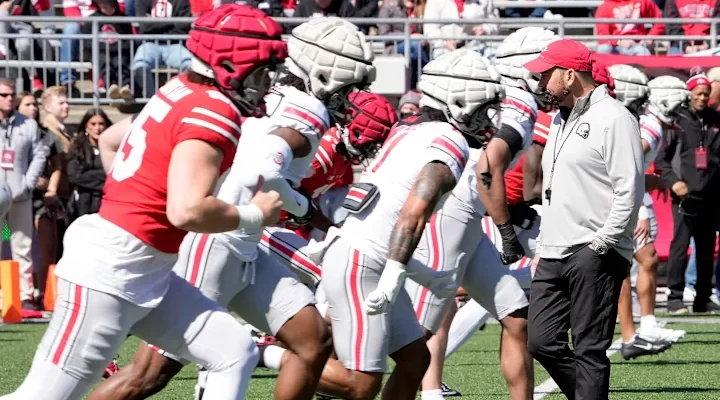Ohio State Football Is Ranked Lower Than Several SEC Teams in ESPN’s 2025 FPI Rankings
As the 2025 college football season draws near, Ohio State football finds itself in an unusual and controversial position: despite being a perennial national title contender, the Buckeyes are ranked lower than several SEC teams in the ESPN Football Power Index (FPI) projections. This unexpected hierarchy has sparked spirited debates among fans and analysts, not only about the Buckeyes’ national standing but also about the broader narrative of SEC dominance in the college football landscape.
The FPI, designed to be a predictive tool rather than a traditional ranking, aims to measure team strength and project future performance. Factors include returning production, recruiting classes, past performance, coaching efficiency, and strength of schedule. While the Buckeyes’ 2024 season ended with a strong finish, they now enter 2025 with questions that have likely contributed to their FPI standing.
In the 2025 FPI, Ohio State has been placed outside the top three, trailing behind at least three major SEC programs: Alabama, Georgia, and Texas. To Ohio State supporters, it’s a frustrating development, especially considering the team’s historic consistency, elite recruiting, and frequent playoff appearances. However, to the neutral observer—or the SEC loyalist—it’s simply the numbers doing their job.
SEC teams dominate the FPI for a variety of reasons. First, their strength of schedule often exceeds that of other conferences. Week in and week out, SEC teams play each other in games that are essentially playoff-level in intensity. That constant crucible sharpens their perceived quality. Second, the depth of talent across the conference is undeniable, with programs like Alabama and Georgia stacking five-star recruits like poker chips.
For Ohio State, which plays in the Big Ten, the path to the postseason is often seen as more manageable. While the Big Ten has strong programs—Michigan, Penn State, and now USC and Oregon following realignment—its top tier isn’t as thick as the SEC’s. This perception may lead computer models to downgrade Ohio State relative to its SEC counterparts, even when the Buckeyes field a team as strong as any in the nation.
While the exact rankings may vary depending on preseason updates, Ohio State finds itself projected behind:
- Alabama: After another elite recruiting cycle and the maturation of their young quarterback, Alabama enters 2025 with sky-high expectations. Their coaching continuity and NFL-caliber talent at virtually every position keep them in the FPI’s top tier.
- Georgia: Kirby Smart’s Bulldogs are once again loaded. Their defense remains dominant, and their offensive system has evolved into a balanced attack capable of putting up points in bunches. Returning a seasoned quarterback only adds to their FPI strength.
- Texas: Now officially an SEC member, Texas has climbed in both recruiting and results. After finally breaking through to playoff contention in 2024, their offensive firepower and a revamped defense position them as a legitimate national title threat.
The FPI’s evaluation considers not just talent but game-by-game probabilities. This is where Ohio State’s strength of schedule may work against them. Even with tough games against Michigan, Penn State, and possibly USC, the Big Ten overall lacks the grueling weekly slate of the SEC, which affects perception and probability models.
Despite the FPI’s caution, Ohio State remains a powerhouse. Their 2025 roster is expected to be among the most talented in the nation, featuring a mix of returning stars and highly ranked freshmen. A few key areas set them up for success:
- Elite Skill Players: Ohio State’s wide receiver room continues to be unmatched. Following in the footsteps of Garrett Wilson, Chris Olave, Jaxon Smith-Njigba, and Marvin Harrison Jr., the 2025 team is expected to field another generational talent or two.
- Strong Defense: With returning leaders in the secondary and a deep defensive line, the Buckeyes will field a unit capable of keeping even the best offenses in check.
- Quarterback Stability: While some uncertainty existed following 2024, Ohio State has a clear plan at quarterback. Whether it’s a returning starter or a highly-touted new face, the position has been well-prepared under their offensive system.
- Coaching and Continuity: The coaching staff, though occasionally under scrutiny in tight games, has maintained a high level of consistency. Adjustments to schemes and game-planning have kept Ohio State competitive in the modern era.
A major part of the FPI discussion comes down to perception. The SEC, rightly or wrongly, is viewed as the premier conference, and that perception influences everything—from preseason rankings to Heisman campaigns to playoff seeding. For programs outside the SEC, like Ohio State, there’s a constant battle to earn respect.
It doesn’t help that recent playoff results have occasionally tilted in the SEC’s favor. Georgia’s championship runs, Alabama’s continued presence, and LSU’s resurgence with Jayden Daniels have reinforced the narrative of Southern superiority. But that narrative doesn’t always align with performance metrics.
In fact, Ohio State has routinely challenged the SEC’s top dogs. Their 2022 playoff game against Georgia came down to a missed field goal. Their national championship win over Alabama in 2014 was decisive. Time and again, the Buckeyes have proven they can play—and beat—SEC teams on the biggest stage.
While preseason FPI rankings are largely speculative, they do shape conversations. Analysts cite them on TV. Fans react to them on social media. Even playoff committees are subtly influenced by them when weighing strength of schedule and quality wins.
For Ohio State, being ranked behind SEC schools might not affect their confidence, but it will fuel motivation. Players and coaches are well aware of the narratives. It becomes bulletin board material. And come fall, every game becomes an opportunity to shift the storyline.
More importantly, games early in the season—especially non-conference showdowns—carry extra weight. If Ohio State faces a top-tier SEC opponent like Texas or Alabama early in the season, that result could redefine the national rankings. A win erases doubts. A loss, depending on performance, might still keep them in the playoff hunt.
Absolutely. The FPI is fluid. As games are played, injuries occur, and breakout stars emerge, the rankings adjust. For Ohio State to move up, they need to:
- Win convincingly: Dominating lower-tier opponents matters. Style points count more than many fans like to admit.
- Beat ranked teams: Wins against Michigan, Penn State, and possibly USC would dramatically shift FPI dynamics.
- Stay healthy: Depth is critical, especially when facing a challenging November stretch.
- Get production from the quarterback: If the starter excels, Ohio State’s offense will be nearly unstoppable, forcing pundits to take notice.
The good news? Ohio State has the infrastructure to accomplish all of the above. Their player development, recruiting consistency, and winning culture provide a solid foundation.
The 2025 season promises to be one of the most compelling in recent memory. With expanded playoffs and conference realignment, traditional powerhouses are being tested like never before. For Ohio State, the challenge is clear: prove the FPI—and the skeptics—wrong.
If history is any guide, don’t be surprised to see the Buckeyes right in the mix come December. Rankings may favor the SEC in June, but football is played in the fall—and in the fall, Ohio State usually delivers.



